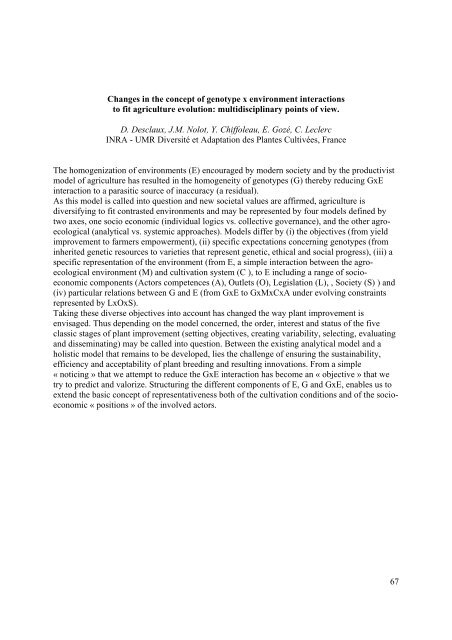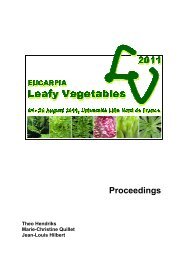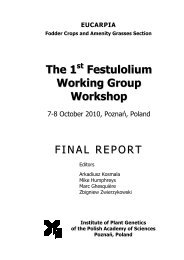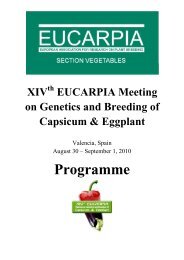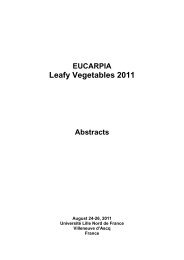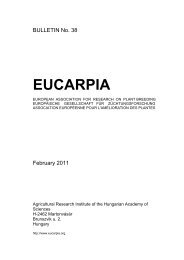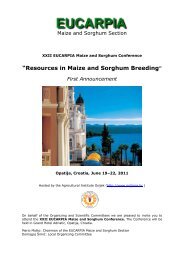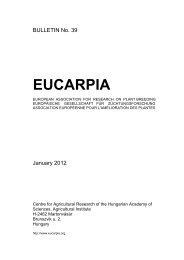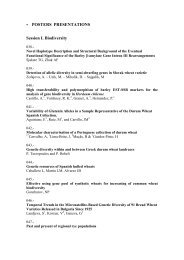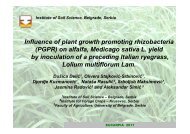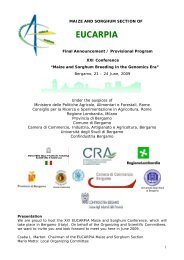Plant breeding for organic and sustainable, low-input agriculture
Plant breeding for organic and sustainable, low-input agriculture
Plant breeding for organic and sustainable, low-input agriculture
You also want an ePaper? Increase the reach of your titles
YUMPU automatically turns print PDFs into web optimized ePapers that Google loves.
Changes in the concept of genotype x environment interactions<br />
to fit <strong>agriculture</strong> evolution: multidisciplinary points of view.<br />
D. Desclaux, J.M. Nolot, Y. Chiffoleau, E. Gozé, C. Leclerc<br />
INRA - UMR Diversité et Adaptation des <strong>Plant</strong>es Cultivées, France<br />
The homogenization of environments (E) encouraged by modern society <strong>and</strong> by the productivist<br />
model of <strong>agriculture</strong> has resulted in the homogeneity of genotypes (G) thereby reducing GxE<br />
interaction to a parasitic source of inaccuracy (a residual).<br />
As this model is called into question <strong>and</strong> new societal values are affirmed, <strong>agriculture</strong> is<br />
diversifying to fit contrasted environments <strong>and</strong> may be represented by four models defined by<br />
two axes, one socio economic (individual logics vs. collective governance), <strong>and</strong> the other agroecological<br />
(analytical vs. systemic approaches). Models differ by (i) the objectives (from yield<br />
improvement to farmers empowerment), (ii) specific expectations concerning genotypes (from<br />
inherited genetic resources to varieties that represent genetic, ethical <strong>and</strong> social progress), (iii) a<br />
specific representation of the environment (from E, a simple interaction between the agroecological<br />
environment (M) <strong>and</strong> cultivation system (C ), to E including a range of socioeconomic<br />
components (Actors competences (A), Outlets (O), Legislation (L), , Society (S) ) <strong>and</strong><br />
(iv) particular relations between G <strong>and</strong> E (from GxE to GxMxCxA under evolving constraints<br />
represented by LxOxS).<br />
Taking these diverse objectives into account has changed the way plant improvement is<br />
envisaged. Thus depending on the model concerned, the order, interest <strong>and</strong> status of the five<br />
classic stages of plant improvement (setting objectives, creating variability, selecting, evaluating<br />
<strong>and</strong> disseminating) may be called into question. Between the existing analytical model <strong>and</strong> a<br />
holistic model that remains to be developed, lies the challenge of ensuring the sustainability,<br />
efficiency <strong>and</strong> acceptability of plant <strong>breeding</strong> <strong>and</strong> resulting innovations. From a simple<br />
« noticing » that we attempt to reduce the GxE interaction has become an « objective » that we<br />
try to predict <strong>and</strong> valorize. Structuring the different components of E, G <strong>and</strong> GxE, enables us to<br />
extend the basic concept of representativeness both of the cultivation conditions <strong>and</strong> of the socioeconomic<br />
« positions » of the involved actors.<br />
67


